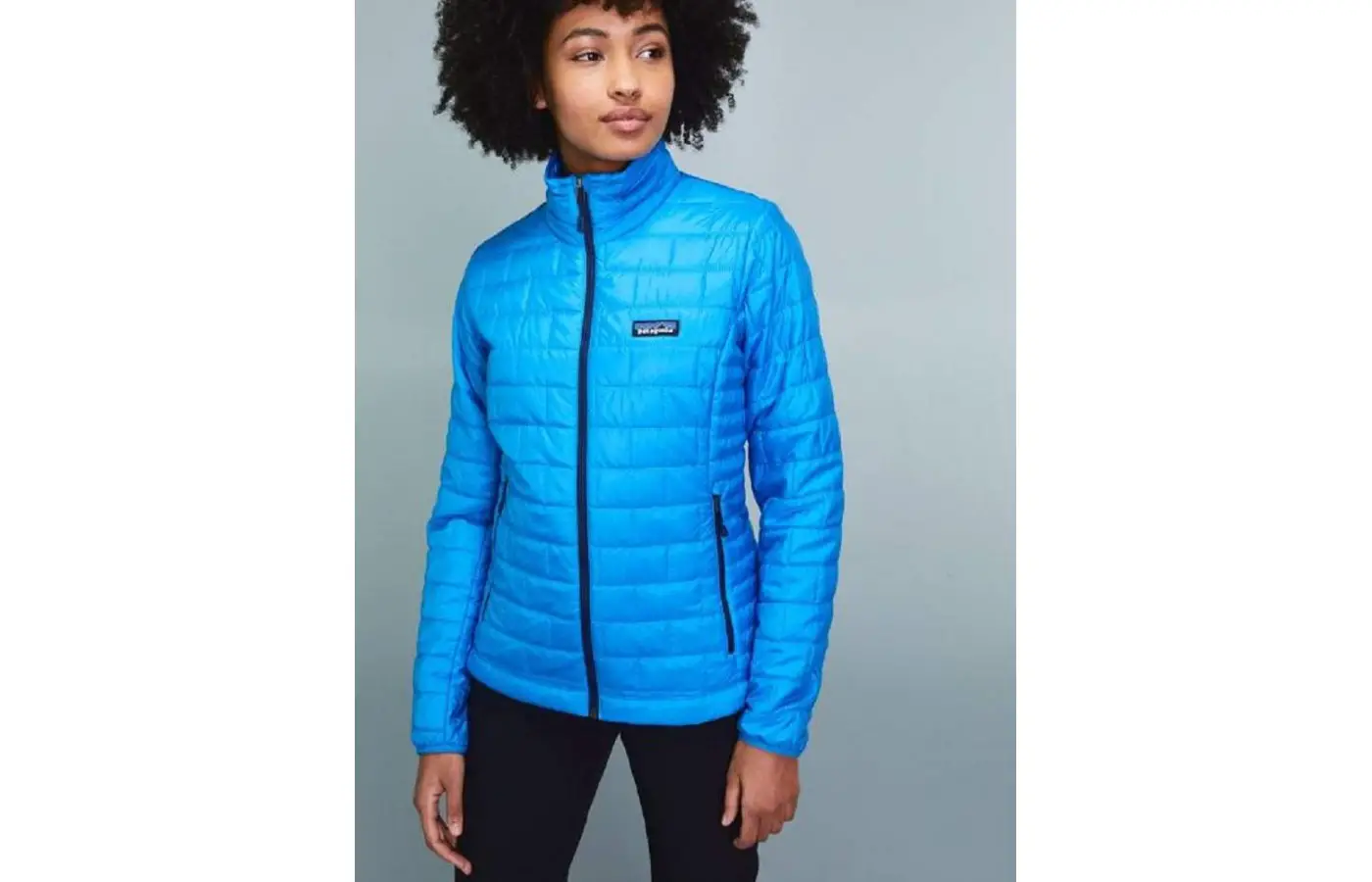Patagonia Nano Puff
A challenge of fishing in the winter is to do it without adding bulk. Bulky clothes keep a person warm but make casting difficult. They also do not fit well in waders. To wear layers on top of waders defeats the purpose.
Highly compressible outer layers are the solution. They must provide wind protection, water resistance, and warmth. A product that is low-bulk and provides serious protection against the elements is the Patagonia Nano Puff Jacket.
It provides a synthetic option to the Patagonia Down Jacket. Both are highly compressed winter jackets to be used as a middle or out component of a clothing system consisting of layers. Today’s technical clothing manages temperature and moisture by combining wicking base layers with proper mid or outer layers.
- Comfortable
- Cost-effective
- Excellent warmth-to-weight ratio
- Keeps warmth in during low activity levels
- Stay warm when wet
- Well-cut
- Not very breathable
- Not stretchy
Brand
Depending on the activity and the time of year, it can be paired with other layers. It works well for backpacking, hiking, camping, and snowsports. The jacket is a ubiquitous crossover piece that can be worn on trails or around town.
Its versatility helps justify a $200 asking price. The sleekness of the Nano Puff Jacket helps it comfortably compress under other gear, as a perfect layer for a session in winter snow, or in a backpack. The current version is an ounce lighter than the original For wilderness pursuits, the warmth potential and technical packability of the jacket comes from its PrimaLoft insulation core.
It is the feature that has changed the most over the years.That feature also places the jacket in line with midgrade down jackets when the warmth-to-weight ratio is taken into consideration. The thin but surprisingly warm layer of insulation is kept in place by a quilted ‘brick’ pattern.
It is the one area of jacket that requires attention. Threading keeps the blocks together. If something hooks on the threads they will come loose. The jacket may not be best suited for highly abrasive activities such as rock climbing.
The PrimaLoft Gold Insulation Eco that Patagonia used as a synthetic insulator is 55 percent recycled polyester. The company claims the use of the fill saved over two million plastic bottles ending up in a landfill in a year.
Ultrafine treated insulation fibers help retain 98 percent of warmth when wet. Patagonia is in continual pursuit of source materials that are easy on the planet. Patagonia has used recycled materials since 1993.
At that time, they turned plastic bottles to fleece. The current recycled liner and shell fabrics of the Nano Puff jacket were introduced in 2009. Patagonia challenged PrimaLoft to make insulation that was more eco-friendly for its best-selling Nano Puff.
An entirely new standard has been set. Airy, 100 percent polyester that is made from recycled material is used for the face fabric and lining as well. Even the label and zipper are partially recycled materials.
The moderate warmth-to-weight ratio maintained by PrimaLoft Gold Eco insulation ensures the wearer stays warm, even when wet. The Patagonia Nano Puff Jacket has been available since 2010. It is among the brand’s best-selling products because it warms, stuffs, puffs, and packs with remarkable versatility.
Breathability
In cold weather, sweat is not sufficiently wicked away close to the body. It is sticky and cold on the wearer’s core. A wet and cold core is undesirable. When the activity level in the Nano Puff is being pushed, a dialed base layer is needed.
Comfort
For next-to-skin comfort, the jacket has a zipper garage at the chin, an interior storm flap, and a center-front zipper. The zipper garage and storm flap discourage chin chafing — an internal chest pocket doubles as a storage area for the jacket. The jacket can be stuffed in the pocket, chucked in a bag, and forgotten about when the temperature becomes warmer.
Durability
It is the most efficient thermal synthetic insulation available. The insulation is water repellent. On the side panels of the jacket, a brick quilting pattern having narrow horizontal quilt lines stabilizes the insulation.
A durable thread is used for abrasion resistance. The dual-adjust drawcord hem and elasticized cuffs seal in warmth and seal out the wind. The dual-adjust drawcord hem and elasticized cuffs seal in warmth and seal out the wind.
The shell decently holds up and repel rips in multi-user scenarios. An exterior DWR coating provides added protection from the weather. The material used in making the jacket is bluesign approved fabric. It meets a stringent standard of bluesign.
Patagonia deliberately took steps while manufacturing and producing the jacket to minimize the negative impact on the environment, workers, and customers. A stuff pocket is tucked away when wearing the jacket and ready to be used to pack the jacket away when not being worn.
The jacket is incredibly packable. It stuffs into the chest pocket by compressing like a down jacket and disappears into a backpack. There are cleanly finished zipper garages for the handwarmer pockets. The internal zippered chest pocket has a reinforced clip-in carabiner loop.
Size
Use
The Nano Purll is suitable for the majority of the season. Whether sitting by a campfire enjoying s’mores or cruising on a famed Castle Rock route, the Patagonia Nano Puff Jacket is insulated and provides lightweight warmth.
The most recent version is fashioned a bit more narrow than in the past. Horizontal baffling is more than a pretty face. It is in place to provide maximum warmth. The jacket has a fully adjustable hem with a low-profile drawcord.
Flexibility
It packs down small enough to be stowed at the back of a fishing vest or a large hip pack. The compressibility means a lot when layering under waders. The jacket fits under waders like a shirt. Properly fitting waders make a significant difference when spending a long day in the water.
Cleaning
Biodegradable, non-toxic types are preferred. Dry on a clothesline for best results. Wash the jacket only when necessary. It conserves water and minimizes wear and tear of the jacket. Studies have shown that synthetic jackets washed in top-loading machines shed over five times the amount of microfibers than jackets washed in front-loading machines.
If possible, line dry the jacket. Turn dark and bright jackets inside out. It will reduce fading. Hang from the bottom, so clothespin marks are less conspicuous. Line drying reduces environmental impact and saves energy.
If a dryer is used, tumble dry on a low setting. Fabric softeners improve the feel of the jacket by depositing waxy agents. The waxy residue can impair quick drying and moisture wicking, and inhibit odor control.
Style
It is big enough for a small hydration bladder, buff, or hat. When saving space is essential, the zippered square stuff sack easily compresses to fit in a minimalist pack. There are two zippered hand pockets to keep necessities such as supplies and snacks close at hand.
The Hoody version adds weather blocking option for the head. The hooded jacket is a bit pricey. The MSRP is $250. If the feature is of importance to the wearer, the price may be worth it. The hood zips high to protect the neck.
It is slim fitting and not adjustable. The ‘scuba style’ hood has stretchy, durable trim. It wraps snugly at the forehead and chin. Those who have a proportionally small or large head might want to try on the jacket before buying it.
Water Resistance
When the Nano Puff gets wet, it dries quickly. Other jackets remain wet until placed near drying sources. Even when wet, the jacket doesn’t stop insulating. It is good to know a wet jacket won’t stop keeping the wearer warm.
The PrimaLoft synthetic fill of the jacket is the cause of the water-resistant performance. Unlike down, the synthetic fill works when soggy. Moisture beads up and runs off quite well. However, the jacket can be drenched in the rain.
It is not waterproof. There is a saturation point. When rain is predicted, it is wise to have a waterproof shell and count of the jacket as light and warm layer that provides most of the protection before and after it rains.
Wind Protection
Only jackets that had considerably more bulk offered better wind protection. The Nano Puff is suitable for all but extremely blustery days. When tested on a downhill ski run on a breezy day in 30° weather, a single layer beneath the Nano Puff jacket provided adequate wind protection.
Key Features
* Insulated
* Lightweight
* Recycled ripstop exterior
* Synthetic
Bottom Line
Being able to stuff the jacket into its zippered chest pocket was the most prominent feature when first listed by reviewers. The highly packable jacket sported fundamental water-resistant and windproof properties essential for outdoor adventures.
Those qualities still exist. The popularity of the jacket spurred other products that Patagonia Nano Puff. They include puffy pants, a vest, bivy pullover, pullover, and hoody. There are options for children, women, and men.
















